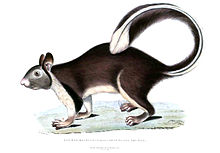Sri Lankan giant squirrel
| Sri Lankan giant squirrel | ||||||||||||
|---|---|---|---|---|---|---|---|---|---|---|---|---|

Sri Lankan giant squirrel ( Ratufa macroura ) |
||||||||||||
| Systematics | ||||||||||||
|
||||||||||||
| Scientific name | ||||||||||||
| Ratufa macroura | ||||||||||||
| ( Pennant , 1769) |
The Sri Lankan giant squirrel ( Ratufa macroura ) is a type of squirrel from the genus of the giant squirrel ( Ratufa ). It occurs in South Asia in southern India and on the island of Sri Lanka .
features
The Sri Lankan giant squirrel reaches a head-trunk length of around 33.5 to 36.5 centimeters and a weight of around 1650 grams. This makes it one of the largest squirrel species worldwide, along with other species of the genus and representatives of other genera. The tail reaches a length of about 35 centimeters and is thus about as long as the rest of the body. The back fur and head fur of the animals is dark brown to blackish gray with a light stripe between the ears, the belly side as well as the legs with the exception of the toes are light yellowish.
| 1 | · | 0 | · | 1 | · | 3 | = 20 |
Like all species of the genus has the type in the upper jaw half per one to a incisor tooth formed incisor (incisor) to which a tooth gap ( diastema follows). This is followed by a premolar and three molars . The teeth in the lower jaw correspond to those in the upper jaw. In total, the animals have a set of 20 teeth.
distribution

The Sri Lankan giant squirrel is found in South Asia in southern India in Kerala and Tamil Nadu and on the island of Sri Lanka . In India the species is only known from five separate and highly fragmented regions, in Sri Lanka it is more widespread and occurs in less fragmented areas. The altitude distribution ranges from about 150 to 500 meters in India and up to heights of 2500 meters in Sri Lanka.
Way of life
As is the case with most squirrels, little data or observations are available on the way of life of the Sri Lankan giant squirrel. Like all species of the genus, it is largely tree-living ( arboricol ) and lives in the tropical rainforests of the range.
The squirrels feed primarily on the young leaves of the Albizia , which, together with other plants such as Terminalia , Tamarindus , Mangifera , Pongamia and Syzygium, dominate the habitat, especially in the Western Ghats .
Systematics

The Sri Lankan giant squirrel is classified as an independent species within the genus of the giant squirrel ( Ratufa ), which consists of four species. The first scientific description comes from Thomas Pennant from 1769, who described the species as Sciurus macrourus on the basis of individuals from central Sri Lanka from the central province and the province of Uva . There are also numerous other synonyms for this species.
Within the species, a total of three subspecies are distinguished with the nominate form :
- Ratufa macroura macroura : Occurrence in central Sri Lanka
- Ratufa macroura dandolena : Found in southern India and in eastern to north-central Sri Lanka
- Ratufa macroura melanochra : Occurrence in southwestern Sri Lanka
Status, threat and protection
The Sri Lankan giant squirrel population is likely to be significantly declining, with the rate of decline estimated to be less than 30 percent of the population over the past ten years or three generations. The threat to the remaining populations in India is significantly higher than that of the stocks in Sri Lanka.
The main threats to the Sri Lankan giant squirrel include deforestation and hunting in most of its range. It is classified as Near Threatened by the International Union for Conservation of Nature and Natural Resources (IUCN) for these reasons.
supporting documents
- ↑ a b c d e f g Richard W. Thorington Jr. , John L. Koprowski, Michael A. Steele: Squirrels of the World. Johns Hopkins University Press, Baltimore MD 2012, ISBN 978-1-4214-0469-1 , pp. 26-28 .
- ^ Robert S. Hoffmann, Andrew T. Smith: Ratufa. In: Andrew T. Smith , Yan Xie: A Guide to the Mammals of China. Princeton University Press, Princeton NJ 2008, ISBN 978-0-691-09984-2 , p. 173.
- ↑ a b c d e f g h i j Ratufa macroura in the Red List of Threatened Species of the IUCN 2014.2. Posted by: J. Joshua, J., WILDPTS de A. Goonatilake, S. Molur, 2008. Retrieved October 14, 2014.
- ↑ a b c Ratufa macroura In: Don E. Wilson , DeeAnn M. Reeder (Ed.): Mammal Species of the World. A taxonomic and geographic Reference. 2 volumes. 3. Edition. Johns Hopkins University Press, Baltimore MD 2005, ISBN 0-8018-8221-4 .
literature
- Richard W. Thorington Jr. , John L. Koprowski, Michael A. Steele: Squirrels of the World. Johns Hopkins University Press, Baltimore MD 2012, ISBN 978-1-4214-0469-1 , pp. 28-29 .
Web links
- Ratufa macroura inthe IUCN Red List of Threatened Species 2014.2. Posted by: J. Joshua, J., WILDPTS de A. Goonatilake, S. Molur, 2008. Retrieved October 14, 2014.